How can I clean a ceramic plate and how to do it right?
Content:
Caring for the surface of a ceramic glass hob is an easy task if you wipe it after each meal. But how to clean a glass-ceramic plate from burnt grease and dried spots, so as not to scratch and damage the surface?
General rules for the care of glass ceramics
Electric stoves with a glass-ceramic surface are very convenient, but there are some nuances in caring for them. The hob can only be washed after cooling, that is, after all residual heat indicators go out. An exception is if syrup or jam has been spilled on the stove. In this case, you need to immediately clean off the pollution with a scraper, but with sponges you can wipe only after cooling.
Another feature - not all devices with which housewives clean persistent contaminants are suitable for cleaning. You cannot use the following tools:
- metal brushes and washcloths;
- coarse-grained abrasive substances;
- strongly acidic cleaning chemicals.
Tip
Plastic washcloths do not leave visible scratches, but microdamages remain after them. After regular use, the appearance of the stove deteriorates, and the dirt sticks more and more, so you need to use them as little as possible.
What can be used to clean the stove?
To clean fresh dirt, it is enough to wipe the surface with any soft sponge with detergent, and then thoroughly wash with warm water and wipe with a cloth that absorbs moisture well. For these purposes, it is good to purchase a special glass cloth - microfiber. If the stains still remain, you can spray a small amount of a solution of water and ammonia on the stove and wipe dry.
Such daily cleaning does not cause much difficulty, but how and how to clean the glass ceramic stove from old pollution at home? You can use a special scraper. It can be sold complete with a stove. If not, it can be purchased at the home appliance store along with a glass ceramic detergent.
Scrubbing technology is slightly different from everyday cleaning. The stove needs to be cleaned when it is still warm, or slightly heated, so that the burnt fat is slightly softened. Then, holding the scraper at an angle of 30-45º, pry off the accumulated dirt with it. It is important not to rush, but to remove the burning layer by layer, periodically wiping the surface with a damp cloth.
Another remedy for such cases is a melamine sponge. It erases the dirt like an eraser. Before use, the sponge should be moistened with water. You can also use fine-grained abrasive sponges, such as those suitable for Teflon cookware.
Complex, stubborn soiling is best washed in a combined way.
- Remove the top layer with a scraper.
- Apply detergent.
- Clean the hob with an abrasive sponge.
- Wash the surface with a wet towel, rinsing it all the time, and wipe dry.
- If any dirt remains, wipe it off with a melamine sponge.
What is the most effective chemistry?
The most appropriate option is to use cleaning products designed for glass ceramics. In addition to the ingredients for removing contaminants, they contain substances that create a protective film on glass ceramics. She does not allow the got dirt to eat "tightly" in a surface and facilitates the following cleaning.
Several household companies produce such household chemicals, including manufacturers of glass-ceramic plates. Examples include Domax, Top House, Kochfeld Pflegereiniger and Selena-extra. The last tool is produced by a Russian manufacturer, so the cost is much lower with the same quality as foreign counterparts.
However, not always special tools cope with the removal of strong soot. In this case, it is possible to carry out "resuscitation" measures - to wash a plate with enamel grease removers. Usually they are gels, less often - liquid.
According to reviews, such means are quite effective and gentle for the stove:
- Adriel
- Bagi Grease Shumanit
- KENOLUX GRILL
It is worth remembering that grease strippers are an exceptional measure, and their use can lead to a change in the color of the panel, the appearance of bluish or grayish spots.
Tip
Any household chemicals must be thoroughly washed off the surface in order to prevent prolonged exposure to chemicals on glass ceramics and their burning.
How to remove limescale?
This problem occurs if water often gets on the surface of the panel during cooking. As a result, it evaporates, and hardness salts settle on glass ceramics. There are two ways to wash out a raid - national or factory chemistry. Plate manufacturers recommend the use of cleaning products for glass ceramics or household chemicals for glass. The folk method is also effective and does not damage the surface. In addition, he will help out if there is no household chemicals at hand, and the stove needs to be washed now. How to do it?
- Dilute water with 9% table vinegar in a ratio of 1/1. The required volume is 50-100 ml. 10-20 ml of ammonia can be added to the solution.
- Apply with a sponge or rags to the cooled surface and leave for 10-15 minutes.
- Wipe the hob with a damp cloth and then with a dry cloth.
The most persistent pollution
It is most difficult to remove burnt syrups, jam or milk with sugar from glass ceramics. When sugar is caramelized, it adheres firmly to the surface. Attempts to remove such deposits at home often result in damage to the panel. You can often find tips: "do not cook jam on glass ceramics", "do not allow syrup to get on the stove." But rarely, what kind of mistress will refuse preparations for the winter, and even at the most attentive "cook" jam sometimes runs away. That is why we will consider methods of dealing with the consequence - carbon deposits from syrup.
- If possible, the sweet liquid that has fallen on the surface should be immediately cleaned with a scraper, and after cooling the surface, wash it with a cleaning agent.
- The dark spots remaining after cleaning with a scraper can be removed by abundantly sprinkling them with salt and wiping with a solution of water and vinegar after 15-30 minutes.
- If it was not possible to clean the syrup immediately, you can sprinkle pollution with citric acid and pour a little water. After this, the stove needs to be slightly heated and the burnt sugar removed with a scraper.
- Frozen sugar crust can be removed with a natural remedy - apple peel. To do this, wipe it with contaminated places and leave it on top of soot for 15 minutes, then wash the hob. If not everything is washed off - repeat the procedure.
How hard is it to care for glass ceramics?
For those who are just thinking about acquiring a glass-ceramic plate, a detailed description of the cleaning process for such a surface may seem long, and leaving is difficult. In fact, it’s no harder to take care of such a hob than an ordinary enamel stove. If you choose the right tools and detergents, then cleaning will require very little time and effort.
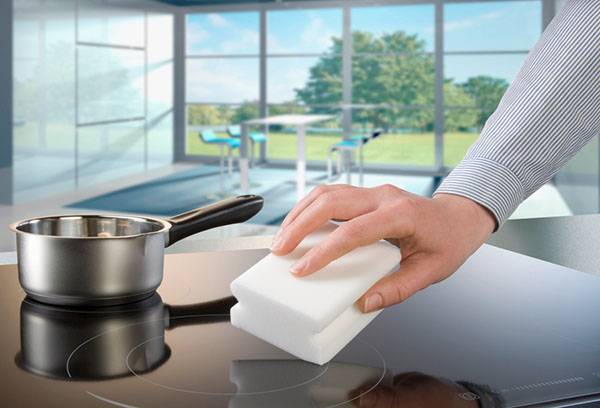
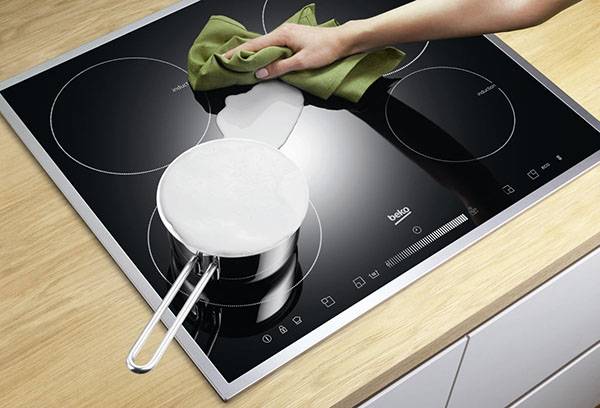
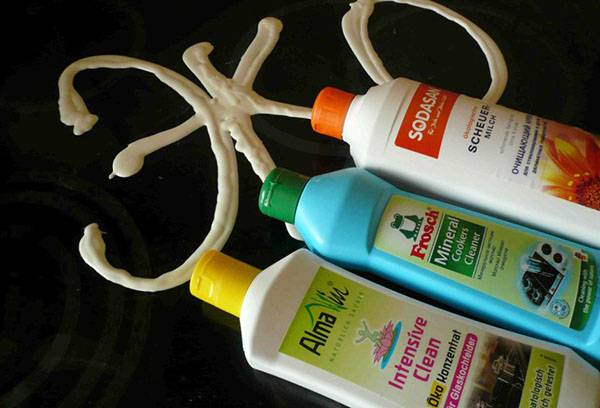
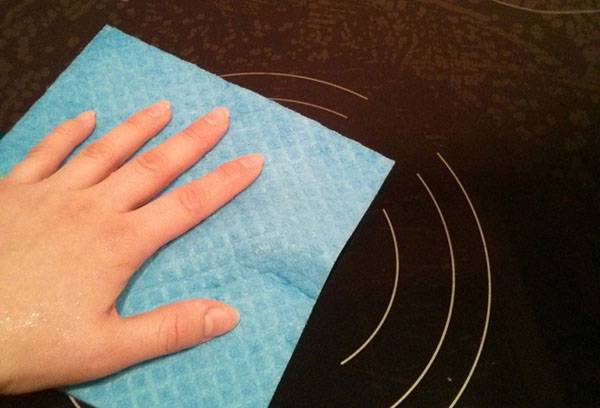
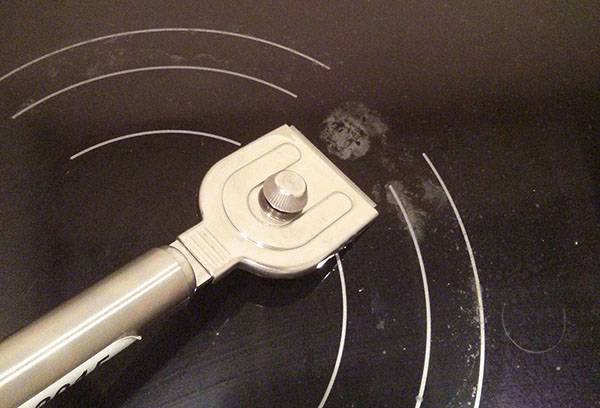
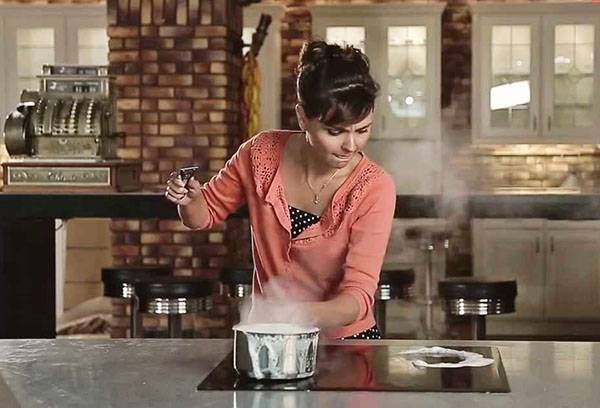
Well, I don’t know how to clean an expensive coffee machine with a lemon, I would be afraid if you never know what. I only clean my special means when I bought a professional tablet in a store with a kit, took them for a long time, and then I bought a kumkumit, it’s also good, there are special additives there so as not to corrode the inner liners, and I think the usual lemon is the last century.